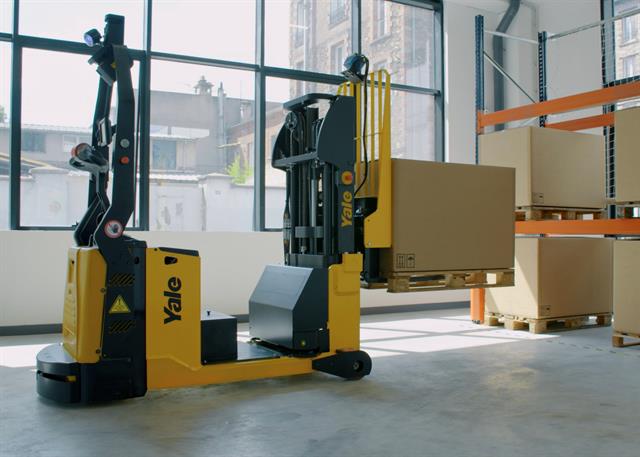 Yale MO50-70T robotic tow tractor |
Yale is seeing growing adoption of its robotics range that can be linked to a warehouse management system but can also be switched to manual operation at the touch of a button.
"At Yale, we've implemented the technology and software in order to offer sophisticated robotic solutions that can adjust to changes in their surroundings, for greater flexibility than solutions that require dedicated navigation infrastructure," says Ron Farr, warehouse solutions manager for Yale.
He cites the robotic Yale MC-10-15 counterbalance stacker that can interact with and access pallets at height - for example, on conveyor belts or second or third shelves up to a height of 1.8 m. The front laser allows the robot to sense the pallet, and the barcode scanner identifies the correct pallet to fulfil the instruction.
"The Yale robots, driven by Balyo geoguidance technology, are fitted with advanced obstacle detection technology which enables it to react to the situation," he says. "Once the robot has detected something ahead, it can control its speed in a smooth and efficient movement to minimise stops and shocks, slowing down to a complete stop if needed."
Farr explains that all trucks in the Yale robotics range, which includes the MO50-70T robotic tow tractor and MO10-25 low level order picker, feature a touchscreen interface to give instructions to the robot, and can all be switched to manual mode at the touch of a button to complete tasks outside of the truck's pre-programmed parameters.
Logistics operators can interact with the robot with real-time truck management. The software can integrate with existing Enterprise Resource Planning (ERP) and Warehouse Management Systems (WMS).
Yale stresses that robotics trucks are ideal for performing repetitive tasks such as movement of pallets in the warehouse environment and loading and unloading.
"Robotics can liberate employees to conduct tasks that humans do best," says Farr. "Having robots working alongside humans leverages the strengths of both to make repetitive tasks and more complex, value-added functions more efficient. It can also provide new opportunities for people with physical limitations to serve as integral parts of the process, as robots can move inventory to pickers and help keep the operation flowing."